कंप्यूटर और सूचना विज्ञान वर्ग
| COMPUTER AND INFORMATICS GROUP | Tapas Samanta | |
| Computer Division | Tapas Samanta | |
| High Performance Computing & IT Services Section | Biswajit Sarkar | |
| General Computing & Networking Infrastructure and Telecom Section | Partha Dhara | |
| Artificial Intelligence Section | Tapas Samanta | |
| Computer Control Division | Anindya Roy | |
| Accelerator Instrumentation Section | Anindya Roy | |
| Fire and Security Surveillance Section | Anindya Roy | |
| Embedded System & ASIC Design Section | Tanushyam Bhattacharjee | |
| Computer & Management Services Section | ||
| Technology Transfer & Co-ordination Division | Tapas Samanta | |
Computer Control Division
Overview
Computer Control Division is primarily involved in development, maintenance and upgradation of Control, Data Acquisition & Diagnostic Systems for Room Temperature Cyclotron (RTC), Superconducting Cyclotron (SCC), Medical Cyclotron, Electron LINAC and various experimental facilities of the centre. The development of control and data acquisition systems for the Magnetic Field Mapping (MFM) of SCC, RTC and upcoming Medical Cyclotron are the other important activities of this division. The division is also engaged in developing State-of-the-art Instruments e.g. vacuum gauge controller, nano-ammeter, RF power meter, alarm annunciator, etc. and various EPICS software tools.
Accelerator Instrumentation Section
The main activity of the section is the development of Experimental Physics & Industrial Control System (EPICS) based state-of-the-art distributed control system for Room Temperature Cyclotron (RTC) and Superconducting Cyclotron (SCC). This involves development of Supervisory Control System comprising of Operator Interface (OPI) and Input Output Controller (IOC) for the following subsystems of the cyclotrons.
High current power supplies for various magnets
High voltage power supplies
PIG ion source
Beam diagnostic system
Cyclotron control console
vacuum system
LCW system
Cyclotron status monitoring facility
The section is also responsible for day-to-day maintenance and upgradation of control hardware and software of the above control system. The testing and implementation of latest tools and technologies of EPICS to control system is being done on regular basis. Beside this, the following ARM based EPICS embedded modules are indigenously developed.Beam Diagnostics Controller,
Vacuum gauge controller,
Alarm Annunciator
Power supply controller
The following EPICS Software Tools have also been developed.CA Activex components for OPI,
EPICS MySQL Archiver for control system data logging
web based E-Log for operator log
The development of the following electronics/ controller/ position encoder readout electronics, jig movement controller and software for control and data acquisition for MFM system is an important activity of this section. The indigenously developed MFM system for SCC is capable of acquiring 106 field data point in around 180 minutes without human intervention.The section indigenously develops the following precision instruments as import substitution.
nano ammter
RF power meter
charge integrator
SiPM based phase measurement with latest technology and connectivity
The section is also entrusted with the development of control system for prototype medical cyclotron.Journal
[1] Anindya Roy, R. B. Bhole, Partha P. Nandy, R. C. Yadav, Sarbajit Pal, and Amitava Roy, "Implementation of EPICS based vacuum control system for Variable Energy Cyclotron Centre, Kolkata", REVIEW OF SCIENTIFIC INSTRUMENTS 86, 033306 (2015)
Seminar/Conferences/Symposia
[1] Anindya Roy, Shantonu Sahoo, Sarbajit Pal, ‘Application of EPICS Control System Studio in VECC’, Proc. of INPAC 2019, Inter-University Accelerator Centre, New Delhi, India,
[2] Shantonu Sahoo, Arihant Jain, Anindya Roy, ‘EPICS based Embedded Control System Architecture for Electron Gun of E-LINAC’, Proc. of INPAC 2019, Inter-University Accelerator Centre, New Delhi, India,
[3] Anindya Roy, Partha Pratim Nandy, R. B. Bhole, Sarbajit Pal, Amitava Roy, ‘Development of EPICS Enabled Alarm Annunciation System’, Proc. InPAC-2018, Raja Ramanna Centre for Advanced Technology, Indore, India.
[4] Niraj Chaddha, R.B.Bhole, J. Pradhan, P. P. Nandy, Sarbajit Pal, ‘Instrumentation for Position Measurement of Magnetic Median Plane of SCC and Error Analysis’, Proc. InPAC-2018, Raja Ramanna Centre for Advanced Technology, Indore, India.
[5] Shantonu Sahoo et. al, "ARM based embedded EPICS controller for beam-diagnostics of cyclotrons at VECC", proc. ICALEPCS-2013, Oct-2013,
[6] Anindya Roy et. Al, "Filed mapping of K=500 superconducting cyclotron magnet for correction of harmonics with trim coils", Proc. InPAC-2013, pp 752-754.
[7] S. Sahoo, T. Bhattacharjee,S.Pal, “Development and Performance analysis of EPICS Channel Access Server on FPGA based Soft-core Processor”, International Conference on Personal Computers and Particle Accelerators, PCAPAC’12 , Kolkata, December 4-7 (2012).
[8] N.Chadda, S.Sahoo, R.B.Bhole, S.Pal, “Modular Beam Diagnostics Instrument Design For Cyclotrons”, PCAPAC’12 , Kolkata, December 4-7 (2012).
[9] Anindya Roy, R. B. Bhole, Sarbajit Pal, “Development of EPICS Channel Access Embedded ActiveX Components for GUI Development”, Proc. of International Conference on Personal Computers & Particle Accelerator Control, PCAPAC’12 , p54-56, December 2012
[10] Anindya Roy, R. B. Bhole, Sarbajit Pal, D. Sarkar, VECC, India, “EPICS MySQL Archiver – Integration between EPICS and MySQL”, Proc. of International Conference on Personal Computers & Particle Accelerator Control, PCAPAC’12, p109-111, December 2012
[11] Tanushyam Bhattacharjee, Anindya Roy, Rajendra Balkrishna Bhole, Gaurav Saxena, Kaushik Datta, Tapas Samanta, Sarbajit Pal, Debranjan Sarkar, "Facility Monitoring SystemusingStorage Area Network for VEC and SCC",in the Proceedings of 9th International Workshop onPersonal Computers and Particle Accelerator Controls (PCaPAC-2012), VECC, Kolkata, December 4-7(2012).
[12] Niraj Chaddha, R. B. Bhole, Sarbajit Pal, ‘Multiple Parameter Control Using Soft-Console’, Proc. of INPAC 2011, Inter-University Accelerator Centre, New Delhi, India, February 2011.
[13] R. B. Bhole, Anindya Roy, Joydeeo Mishra, Sarbajit Pal, ‘Trim Coil Temperature Control System fpr SCC’, roc. of INPAC 2011, Inter-University Accelerator Centre, New Delhi, India, February 2011.
[14] Anindya Roy, R.B. Bhole, J. Akhtar, R.C. Yadav, Sarbajit Pal, D. Sarkar, R.K. Bhandari, ‘Vacuum system of cyclotrons in VECC, Kolkata’, Proc. of XII IEEE International Vacuum Electronics Conference (IVEC-2011), Bangalore, India, February 2011.
[15] Niraj Chaddha, R. B. Bhole, Tanushyam Bhattacharjee, Anindya Roy, Sarbajit Pal, 'Embedded Systems for Diagnostics & Control Used in VEC and SCC', Proc. of SACET-2009, VECC, Kolkata, October 2009.
Embedded System & DSP Section
1. Development & implementation of Front end electronics and readout electronics for a prototype SiPM based Gamma imaging system using FPGA.
2. Implementation of FPGA based multi channel High speed Data acquisition system for nuclear spectroscopy using PCIe connectivity using high speed ADC.
3. Design and implementation of an FPGA based embedded measurement and controller unit for LLRF e-LINAC cavity control.
Computer Division
Overview
The Computer Division, under the Computer & Informatics Group, VECC, provides all sort of computational requirements, IT services, Network Connectivity and Data Acquisition support to VECC. Apart from these, it also does Research & in-house Development in the areas related to the activities of three constituent sections, i.e. the High Performance Computing and Information Technology Services (HPC&ITS) Section, the General Computing and Network Infrastructure Services (GC&NIS) Section and the Artificial Intelligence (AI) Section.
Artificial Intelligence Section
The AI section has the following distinct areas of research and development activities
- Software development for Speech to Sign Language conversion and Vice for the deaf and dumb.
- Hardware development for ultralow current/charge measurement with hardware support for sectional requirements.
- Embedded system development for RF ID based systems
- Research & Development on Swarm Robotics,
Software development for Speech to Sign Language Conversion and Vice Versa
Still there is lacuna in the available tools for the deaf and dumb community to communicate with the general population. An R&D project for development of a light weight interface for conversion of speech to Indian Sign language (and vice-versa) based on HAMNOSYS (Hamburg Notation System) using avatar (synthesized humanoid). The System will act as a bridge between the communication modality of the speech and hearing impaired people and the people from the mainstream of the society. The system consists of two components - a Forward Translation System and a Reverse Translation System.Forward Translation system provides real-time translation of spoken English words/numbers to its corresponding sign gesture. Reverse Translation System provides real-time recognition of finger spelled gesture articulated by a human user from a given gesture video to the corresponding texts. The proofs of concept for both have been demonstrated.
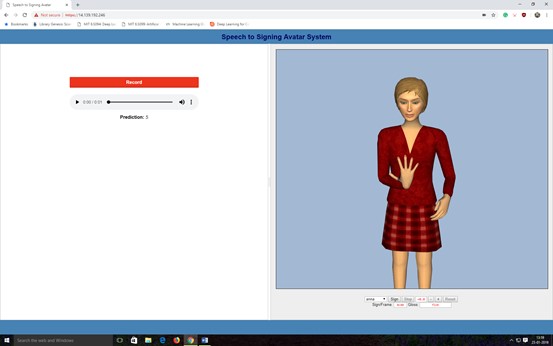
Speech to Sign Language Translation: A Proof of Concept 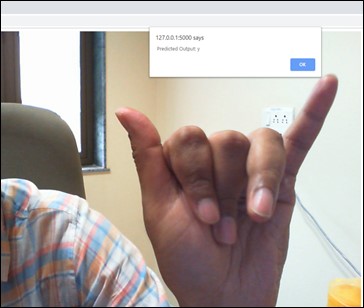
Sign Finger Spelling to Text
Embedded system development for RFID based system
The AI section are involved in RFID based embedded system development. Various RFID reader/writer modules with enhanced range are already developed for RFID based handheld attendance recording system, RFID based Library book Issue/Return System, RFID based Library Stock verification system etc.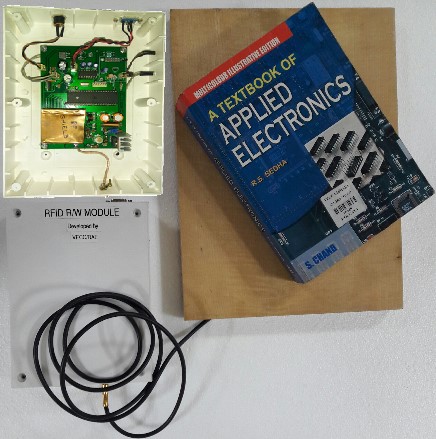
The RFID based book Issue/Return system 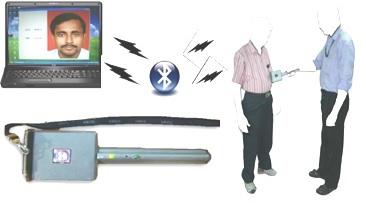
Hand-held RFID reader deployed at VECCHardware development for Ultra-low Current/Charge measurement
To fulfill the in-house requirement of cyclotron beam current/charge with high precision, the AI section took up development of hardware for ultra-low charge/current measurement since 2015. It has successfully designed and developed three different model of Pico-ampere meters. All these technologies are transferred to the private entrepreneurs for commercial productions. The latest development is the mini-Pico ampere meter- a miniature (5.1x4.1x1cm3) version of the dual channel digital Pico-Ammeter capable of measuring current from 1pA to 20µA which may be monitored on a local LCD or in PC based GUI application software.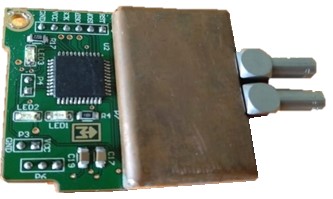
Mini Digital Pico-Ammeter Module 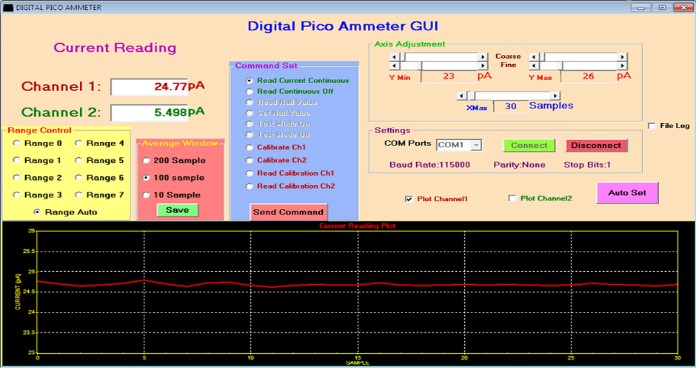
GUI Application Software Laboratory Comparison Results Laboratory Comparison Results All these technologies are transferred to the private entrepreneurs for commercial productions. Presently, three technologies have been successfully transferred to three different private entrepreneurs from Eastern, Sothern and Western part of India for commercial production. The entrepreneur from Pune has successfully launched the product and their first product has already been sold.
Research & Development in the area of Swarm Robotics:
Individual robot with high capabilities are costly, involve high-end technologies to manufacture them and difficult to deploy them in unknown terrain. Comparatively, cheap and limited capability robots are easier to make and operate. A group of such limited capability robots can be programmed to do with ease the same job that an individual robot can do. Such group of robots are called Swarm-Robot. Research on the maneuvering such swarm of robots involve, dynamic localization, collision avoidance, collision detections both within the group and with outside obstacles, making various formation as required by the deployed by known/unknown terrain and target following etc. Moreover, there are various deployment problems like coverage, mowing etc. similar to individual robots. The activities of R&D on swarm robotics targets towards achieving them using both Arial and Terrestrial Swarm-Robots. These activities are initiated very recently and prototype unmanned aerial vehicle has been developed.The prototype has been developed with the envisaged applications ranging from perimeter surveillance to atmospheric radiation mapping etc.
The weight of the developed prototype is approximately 1kg with a designed TWR (Thrust to Weight Ratio) of 2:1 i.e. it has a payload capacity equal to its own weight.
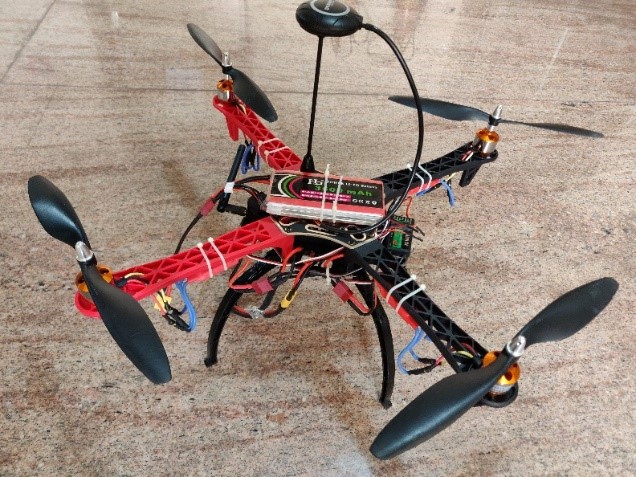
The quad-copter developed by AI section in landed condition at floor level.
The quad-copter developed by AI section in landed condition at floor level.
In both Manual and Autonomous Modes, the failsafe safety features (e.g. loss of communication with Remote Control, loss of GPS and low battery) are incorporated to manoeuvre the quad-copter to safe landing.General Computing & Networking Infrastructure Section
The GC&NIS involves in providing secure network and Internet access to all the campuses of VECC, providing general purpose computing servers for scientific computing and development of data acquisition system for nuclear physics experiments. The section is involved in providing round the clock user support for computing and network related issues, as well as engaged in R&D activities in the field of hardware and software development, network connectivity and cyber security.
It also provides the state of the art hardware and software resources for the nuclear physics experiments. The front end electronics involve in-house hardware development capability along with the procurement of industry standard hardware. Standard hardware i.e., NIM, CAMAC or VME modules/crates are procured while the requirement specific hardware are developed in-house. Presently, Digital Data Acquisition Systems are being developed to replace bulky and costly analog frontend electronics modules with low cost FPGA based digital system with many advanced features. The DAQ software development for collecting, storing and processing of experimental data is also pursued. A new controller software is being developed to control different digital DAQ stations from a single Master controller.
For General purpose computing, a 2TFlops SMP server KANAAD has been commission with 64 cores, 3TB Memory, 15TB disk space and CENTOS 7.2 Linux. The system is extensible being used by Physicists, students and engineers of the center to run their codes. Section is also extending help to all the users in migration, installation or improvement of the user codes.
High Performance Computing & IT Services Section
High Performance Computing & IT Services Section (HPC&ITSS) is primarily involved in the day-to-day operation, maintenance, system administration and user support for high-performance computing and various critical IT services of VECC.
At present a 96-node computing cluster, christened “Himalaya”, with 2304 cores and 92 TFLOPS of computing power (Theoretical Peak Performance) forms the mainstay of the high-performance computing infrastructure of the Centre.
HPC&ITSS is engaged in the development, upgradation, operation and maintenance of various IT services and applications. Critical IT Services like WWW, DNS, E-mail, Proxy, DHCP, End-Point-Security (Antivirus) and Data Backup etc., along with development of various web-based application software, as per the requirements of the Centre.
Data Acquistion & Computer Control Division
DAQ Development and ASIC Design Section
Overview:
ASIC Design Section, under the Applied Electronics Division primarily associated with monolithic mixed-signal design, fabrication, testing and deployment of state-of-the-art indigenous electronics circuit and data acquisition system required for the experimental nuclear physics programme of the centre. The upcoming K-500 superconducting cyclotron will be producing accelerated ion beams of intermediate energy (~ 10-80 MeV/A) for conducting nuclear physics experiments. The front-end electronics and DAQ for such experiments requires integration of thousands of granular radiation detectors within a confined space. The fundamental principles of signal processing from those detectors are to embed the front-end signal processing circuits with the detectors inside vacuum chamber to reduce noise and interference for good energy and time resolution required in such experiments. These detector systems also require a data acquisition set-up which is capable of handling high count-rate and capabilities of processing data of high volume. The spin-offs of the developments of the Section are also being utilized in the other areas of requirements.
Research and Development:
The present engagement of the Section consists the development of complete application-specific front-end electronics (ASICs) and DAQ for segmented detector arrays. Two such Charged Particle Detector Array (CPDA) are to be used for intermediate nuclear physics experiments and Granular charged-particle Multiplicity-filter Detector Array (GMDA) for particle tagged gamma spectroscopy. The Section has also successfully designed integrated CMOS chip for the Neutron Flux Monitor (NFM).
The following facilities are also available in the section. (I) Design stations for deep-submicron CMOS technology (II) Chip-on-Board (CoB) bonding (III) Testing stations of fabricated integrated circuits (IV) Clean Room
The present R&D activities are enumerated as follows:
A. Multichannel Low noise, low power high dynamic range Charge Sensitive Preamplifier (CSA) for CPDA
VECC-001, a 16 channel charge sensitive amplifier was successfully designed, fabricated and tested to replace Mesytec MPR-16 CSA module used in CPDA.
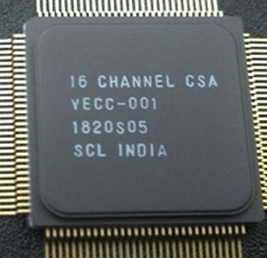
Specifications:
3 Modes of operation: CPDA (∆E and E Si detectors), GMDA (CsI (Tl)
detector)
Variable dynamic range (500 fC, 1200 fC & 4500 fC)
High GBW OTA with variable Phase margin compensation
Low noise ≈ 1400e with 5.5e/pF slope
Linearity < 0.2%
Capable to handle high input capacitance ≈ 350pF
Developed in 180nm CMOS SCL technology
B. Low power variable shaping time preamplifier and shaper for GMDA
The GMDA-01 (an 8 channel charge preamplifier with complex conjugate fifth order variable peaking time Gaussian shaper) tape-out was submitted to the foundry for fabrication.
Specifications:
Dynamic Range: 3 x 106 electrons
Sensitivity: 2mv/fC
Noise: 300 electrons
Peaking Time: 1µs/3µs
Cross-talk: <1%
Linearity: 1%
C. Integrated CMOS discriminator with Pico-second time resolution
The time pick-off discriminator circuit was designed. The conventional discriminator can work with time resolution of hundreds of pico-seconds. However, our design achieved time resolution in the order of tens of pico-seconds with special design techniques.
D. NFM Chip
The ASIC to replace commercial ICs, being used for indigenous development of electronics for Neutron flux monitor, was designed and submitted for fabrication.
E. Design of two phase peak detector for integration with Digital DAQ
Collaboration:
A Joint Collaborative Agreement (JCA) has been signed on October 4, 2018 at VECC between VECC and SCL for “Fabrication & Packaging of ASICs, designed by VECC, using SCL 0.18µm CMOS Technology for in-house Applications at VECC”.
Publications:
Conference:
1. M. K. Jha et al., “Design and characterization of a charge sensitive amplifier in deep-submicron CMOS for nuclear spectroscopy” in the Proceedings of the ninth DAE-VIE symposium on emerging trends in instrumentation and control and computer systems, June, 2016
2. M. K. Jha, et al., “Design of Multichannel Readout ASIC for particle tagged gamma spectroscopy at VECC”, in the Proceedings of DAE-BRNS Symp. on Nucl. Phys 2019.
3. M. K. Jha, et al., “Design of CMOS peak detector for ASIC integrated with independent digital DAQ for nuclear spectroscopy”, in the Proceedings of DAE-BRNS Symp. on Nucl. Phys. 2019.
4. P. Bahre et al., “Design and Characterization of a Monolithic Non-delay Line Constant Fraction Discriminator for in-house Nuclear Physics Experiments with CPDA at VECC”, in the Proceedings of DAE-BRNS Symp. on Nucl. Phys. 2019.
M.Tech. Theses:
1. P. Bahre, “Study, design and characterization of CMOS-based timing circuits for nuclear physics applications”, HBNI, 2018-19
2. M. K. Jha, “Study, design and simulation of CMOS based Amplifiers for Nuclear Spectroscopy”, HBNI, 2014-15.
| S.No | Title | Date | Speaker |
| 1 | MONSTER DAQ | Ayan Banerjee | |
| 2 | End-to-end automation of Hand filled forms using Image Processing | Akansha Agarwal | |
| 3 | Control system for Ion source of 18MeV Medical cyclotron | Siddharth Pratihast | |
| 4 | Characterization of ASIC based Indigenous Area Flux Monitor with BARC make BF3 filled neutron detector | Piyush Bahre | |
| 5 | Towards a Semi-Automatic Framework for Translating Indian Sign Language | Pranab Singha Roy | |
| 6 | Cryogenic Electronics for Penning Trap | Neeraj Chaddha | |
| 7 | Identification of Malicious Web Requests through Web Server Log Analysis | Soham Kundu | |
| 8 | Development of Gamma Camera | Santonu Sahoo | |
| 9 | Evolution of nuclear pulse processing methodology for nuclear spectroscopy | Ram Kumar Paul | |
| 10 | Servo Manipulator and its Applications | Shri Ushnish Sarkar | |
| 11 | Superheated liquid detector technique for dark matter search | Prof. Mala Das | |
| 12 | Modelling System for Verification | Dr. Tapas Samanta | |
| 13 | DAQ in HEP experiment | Dr. Susanta Kumar Pal | |
| 14 | Software Engineering: a quick recapitulation | Vineet Kumar Rakesh | |
| 15 | Data Backup & Recovery | Shri Kaushik Datta | |
| 16 | Mean-shift clustering | Shri Biswajit Sarkar | |
| 17 | Application of Digital Signal Processing in Radiation Detection - a review | Shri Tanushyam Bhattacharya | |
| 18 | IT Security for everybody | Shri Gaurav Saxena | |
| 19 | EPICS: A couple of developments | Shri Anindya Roy | |
| 20 | An Introduction to Automata and Languages | Shri Pranab Singha Roy | |
| 21 | Introduction to Clustering Techniques - Part II | Shri Surojit Saha | |
| 22 | Introduction to Magnet Characterisation Facility | Shri R. B. Bhole | |
| 23 | Analysis and Design of Algorithms: Dynamic Programming | Shri Gaurav Saxena | |
| 24 | Design of Low Power Reference voltage in ASIC for Nuclear Spectroscopy | Shri Manish Kumar Jha | |
| 25 | Technology behind RFID | Shri Subhabrata Mazumder | |
| 26 | Web application development in Python using Django | Shri Partha Dhara | |
| 27 | Basics of Computer Networking & Packetfence Network Monitoring System | Shri Somesh | |
| 28 | Introduction to Clustering Techniques | Shri Surojit Sah | |
| 29 | Introduction to Clustering Techniques | Shri Surojit Saha | |
| 30 | Extracting Time Correlation in independent Nuclear Experiment | Shri Ram Kumar Paul | |
| 31 | Web security using https protocol | Shri Monirul Purkait | |
| 32 | Oracle NoSQL Database: An introduction | Vineet Kumar Rakesh | |
| 33 | Development of Low current measurement module | Shri Niraj Chaddha | |
| 34 | Particle Filter and its Application | Shri Biswajit Sarkar | |
| 35 | Multimedia Conferencing over Packet-based Networks and Security aspect | Shri Tapas K. Bhaumik | |
| 36 | Parallelizing Machine Learning Algorithms on Multicore using F# | Shri Pranab Singha Roy | |
| 37 | Optimization Techniques | Shri Gaurav Saxena | |
| 38 | An Overview of Web Application Security: Attacks & Countermeasures | Shri Kaushik Datta | |
| 39 | Digital Synthesis of a trapezoidal pulse shape in real time for radiation spectroscopy | Shri Madhusudan Dey | |
| 40 | Various techniques for improvement of electronic resolution in radiation spectroscopy- a study | Shri Tanushyam Bhattacharya | |
| 41 | Version Control System, based on Subversion | Shri Surojit Saha | |
| 42 | An Introduction to Microsoft F# and its implications to Parallel and Scientific computations | Shri Pranab Singha Roy | |
| 43 | An Introduction to Microsoft F# and its implications to Parallel and Scientific computations (Part II) | Shri Pranab Singha Roy | |
| 44 | Modernization of Control System of the Scattering Chamber of K130 Room Temperature Cyclotron | Shri Tapas K. Bhaumik | |
| 45 | Security in Control Networks: Awareness | Shri Gaurav Saxena | |
| 46 | Working with MicroBlaze Soft-core Processor | Shri Shantonu Sahoo | |
| 47 | Journey Through MVC Architecture in Developing Software for APAR and IPR | Shri Monirul Purkait | |
| 48 | Digital design techniques with VHDL | Shri Abhishek Singh |
| Article | Author | Journal/Symposium | Year |
| SEU mitigation technique by Dynamic Reconfiguration method in FPGA based DSP application | Madhusudan Dey, Abhishek Singh, Amitava Roy | DAE Symposium on Nuclear Physics, Vol. 57, pp 912-913 (2012) | 2012 |
| FPGA based amplitude control system for accelerating cavities | Madhusudan Dey, Abhishek Singh, Aditya Mondal, Surajit Ghosh, Sumit Som | 9th International Workshop On Personal Computers and Particle Accelerator Controls, held at VECC, 2012 | 2012 |
| Development & Production of ROC SysCore Board V2.2 | M. Dey, A. Roy, S. Chattopadhyay, N. Abel, S. Manz and D. Gottschalk | CBM Progress Report, pp 86, 2012 | 2012 |
| The Multi-crate VME Data Acquisition System | P. Dhara, Amitava Roy, P. Maity, P. S.Roy | DAE Symposium on Nuclear Physics, Vol. 57, pp 916- 917 (2012). | 2012 |
| Design of the Data Acquisition System for the Nuclear Physics Experiments at VECC | P.Dhara, Amitava Roy, P. Maity, P. Singhai, and P. S. Roy | 9th International Workshop On Personal Computers and Particle Accelerator Controls, held at VECC, Oral presentation, 2012. | 2012 |
| Current Development of DAQ at VECC | Amitava Roy | Nustar Week 2012, VECC on October 8-12, 2012 | 2012 |
| Development and Performance analysis of EPICS Channel Access Server on FPGA based Soft-core Processor | S. Sahoo, T. Bhattacharjee, S. Pal | International Conference on Personal Computers and Particle Accelerators, PCAPAC’12 , Kolkata, December 4-7 (2012). | 2012 |
| Modular Beam Diagnostics Instrument Design For Cyclotrons | N.Chadda, S.Sahoo, R.B.Bhole, S.Pal, | PCAPAC’12 , Kolkata, December 4-7 (2012) | 2012 |
| Development of EPICS Channel Access Embedded ActiveX Components for GUI Development | Anindya Roy, R. B. Bhole, Sarbajit Pal | Proc. of International Conference on Personal Computers & Particle Accelerator Control, PCAPAC’12 , p54-56, December 2012 | 2012 |
| EPICS MySQL Archiver – Integration between EPICS and MySQL | Anindya Roy, R. B. Bhole, Sarbajit Pal, D. Sarkar, VECC | Proc. of International Conference on Personal Computers & Particle Accelerator Control, PCAPAC’12, p109-111, December 2012 | 2012 |
| Facility Monitoring SystemusingStorage Area Network for VEC and SCC | Tanushyam Bhattacharjee, Anindya Roy, Rajendra Balkrishna Bhole, Gaurav Saxena, Kaushik Datta, Tapas Samanta, Sarbajit Pal, Debranjan Sarkar | the Proceedings of 9th International Workshop onPersonal Computers and Particle Accelerator Controls (PCaPAC-2012), VECC, Kolkata, December 4-7(2012). | 2012 |
| Magnetic Filed correction and present status of VECC superconducting cyclotron | M.K.Dey et al | Proc. InPAC-2013, pp 852-854 | 2013 |
| Filed mapping of K=500 superconducting cyclotron magnet for correction of harmonics with trim coils | Anindya Roy et. Al | Proc. InPAC-2103, pp 752-754 | 2013 |
| ARM based embedded EPICS controller for beam-diagnostics of cyclotrons at VECC | Shantonu Sahoo et. al | proc. ICALEPCS-2013, Oct-2013 | 2013 |
| Innovative Instrumentation to Measure Magnetic Susceptibility | Nilangshu K Das, Sounak Dey, Sarbajit Pal and P Barat, | IEEE transactions on Magnetics, 49(9), 4965-4969, (2013) | 2013 |
| Development of a fast scintillator based beam phase measurement system for compact superconducting cyclotrons | Tanushyam Bhattacharjee, Malay Kanti Dey, Partha Dhara, Suvodeep Roy, Jayanta Debnath, Rajendra Balakrishna Bhole, Atanu Dutta, Jedidiah Pradhan, Sarbajit Pal, Gautam Pal, Amitava Roy, and Alok Chakrabarti | REVIEW OF SCIENTIFIC INSTRUMENTS 84, 053303 (2013) | 2013 |
| Radiation mapping inside the Bunkers of medium energy accelerators using a robotic carrier | R. Ravishankar, T.K.Bhaumik, T.Bandyopadhyay, M.Purkait, S.C.Jena, S.K.Mishra, S. Sharma, V.Agashe, K.Datta, B.Sarkar, C.Datta, D.Sarkar, P.K.Pal. | Applied Radiation and Isotopes, Volume 80, 2013, pp. 103 - 108 | 2013 |
| Building maps of indoor environments by merging line segments extracted from registered laser range scans | [1] Biswajit Sarkar, Prabir K. Pal, Debranjan Sarkar | Robotics and Autonomous Systems, Volume 62, Issue 4, April Pages 603-615 | 2014 |
| Implementation of EPICS based vacuum control system for Variable Energy Cyclotron Centre, Kolkata | Anindya Roy, R. B. Bhole, Partha P. Nandy, R. C. Yadav, Sarbajit Pal, and Amitava Roy | REVIEW OF SCIENTIFIC INSTRUMENTS 86, 033306. | 2015 |
| A novel method for computation of importance weights in Monte Carlo localization on line segment-based maps | Biswajit Sarkar, Surojit Saha, Prabir K. Pal | Robotics and Autonomous Systems, Volume 74, Part A, December 2015, Pages 51-65 | 2015 |
| Name | Contact Number | Member Details | |
| SK MAHAMMAD IBRAHIM | 4741 | m.ibrahim@vecc.gov.in | Details |
| SOHAM KUNDU | 4720 | soham.k@vecc.gov.in | Details |
| BISWAJIT SARKAR | 4757 | biswajit_s@vecc.gov.in | Details |
| PRITAM PANIGRAHI | 4722 | pritam.p@vecc.gov.in | Details |
| RUPESH KUMAR | 4735 | rupesh.k@vecc.gov.in | Details |
| SUBASH CHANDRA JENA | 4735 | scjena@vecc.gov.in | Details |
| SOUMITRA MONDAL | 4738 | s_mondal@vecc.gov.in | Details |
| SANTU GHOSH | 4748 | santu.ghosh@vecc.gov.in | Details |
| RUMPA JANA | 4738 | rumpa@vecc.gov.in | Details |
| RAMA KRISHNA MEDDO | 2100, 3901 | rk.meddo@vecc.gov.in | Details |
| PRASANTA PAL | 3296 | prasanta@vecc.gov.in | Details |
| PRAMOD KUMAR | 4554 | pramod@vecc.gov.in | Details |
| PINTU MAITI | 1234 | pmaity@vecc.gov.in | Details |
| PARTHA PRATIM NANDY | 4738 | ppn@vecc.gov.in | Details |
| KASHINATH MANNA | 4732 | kmanna@vecc.gov.in | Details |
| GIRIJESH KUMAR | 4732 | g.kumar@vecc.gov.in | Details |
| G. NARAYAN REDDY | 4748 | narayan.reddy@vecc.gov.in | Details |
| DILIP RAJAK | 4727 | diliprajak@vecc.gov.in | Details |
| DIBYENDU KOLEY | 4735 | dibyendu@vecc.gov.in | Details |
| CHANDRAYEE NATH | 4733 | c.nath@vecc.gov.in | Details |
| ARNAB DAS | 4732 | arnab@vecc.gov.in | Details |
| VINEET KUMAR RAKESH | 4734 | vineet@vecc.gov.in | Details |
| USHNISH SARKAR | 4739 | u.sarkar@vecc.gov.in | Details |
| TAPAS SAMANTA | 4725 | tsamanta@vecc.gov.in | Details |
| TANUSHYAM BHATTACHARYA | 4747 | btanu@vecc.gov.in | Details |
| SUDHANSHU SRIVASTAVA | 4757 | sudhanshu@vecc.gov.in | Details |
| SUBHASISH PAHARI | 4722 | s.pahari@vecc.gov.in | Details |
| SUBHABRATA MAZUMDER | 4738 | subhabrata@vecc.gov.in | Details |
| SIDDHARTH VARDHAN PRATIHAST | 4737 | sv.pratihast@vecc.gov.in | Details |
| SHANTONU SAHOO | 4737 | ssahoo@vecc.gov.in | Details |
| RAM KUMAR PAUL | 4724 | rampaul@vecc.gov.in | Details |
| PRANAB SINGHA ROY | 4742 | psroy@vecc.gov.in | Details |
| PIYUSH BAHRE | 4747 | p.bahre@vecc.gov.in | Details |
| PARTHA DHARA | 4745 | partha_dhara@vecc.gov.in | Details |
| NIRAJ CHADDHA | 4737 | nchaddha@vecc.gov.in | Details |
| MONIRUL PURKAIT | 4721 | monirul@vecc.gov.in | Details |
| MANISH K. JHA | 4747 | mjha@vecc.gov.in | Details |
| KAUSHIK DATTA | 4720 | kaushikdatta@vecc.gov.in | Details |
| BISWAJIT SARKAR | 4746 | bsarkar@vecc.gov.in | Details |
| AYAN BANERJEE | 4724 | a.banerjee@vecc.gov.in | Details |
| ANINDYA ROY | 4736 | r_ani@vecc.gov.in | Details |
| AKANKSHA AGRAWAL | 4723 | a.agrawal@vecc.gov.in | Details |




